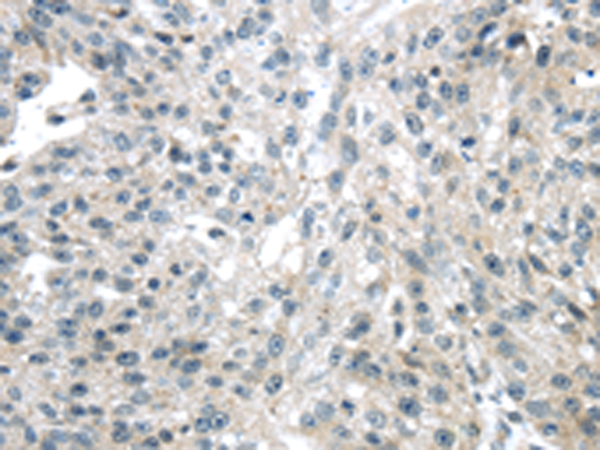
| WB | 咨询技术 | Human,Mouse,Rat |
| IF | 咨询技术 | Human,Mouse,Rat |
| IHC | 1/25-1/100 | Human,Mouse,Rat |
| ICC | 技术咨询 | Human,Mouse,Rat |
| FCM | 咨询技术 | Human,Mouse,Rat |
| Elisa | 1/2000-1/5000 | Human,Mouse,Rat |
| Aliases | RAET1I |
| Host/Isotype | Rabbit IgG |
| Antibody Type | Primary antibody |
| Storage | Store at 4°C short term. Aliquot and store at -20°C long term. Avoid freeze/thaw cycles. |
| Species Reactivity | Human |
| Immunogen | Synthetic peptide of human ULBP1 |
| Formulation | Purified antibody in PBS with 0.05% sodium azide and 50% glycerol. |
+ +
以下是关于ULBP1抗体的3篇参考文献及其摘要概括:
1. **"Tumor-derived soluble ULBP1 modulates NK cell activity via NKG2D"**
*作者:Salih HR, et al.*
摘要:研究揭示了肿瘤细胞释放的可溶性ULBP1蛋白通过结合NK细胞表面的NKG2D受体,抑制其杀伤功能,为肿瘤免疫逃逸机制提供了新见解。
2. **"ULBP1/2/3: Key regulators of NK cell-mediated tumor immunosurveillance"**
*作者:Groh V, et al.*
摘要:该文献系统分析了ULBP1-3在肿瘤细胞表面的表达及其与NKG2D受体的相互作用,强调ULBP1抗体在增强NK细胞抗肿瘤活性中的潜在治疗价值。
3. **"Antibody-mediated blockade of ULBP1 enhances antitumor immunity in preclinical models"**
*作者:Eagle RA, et al.*
摘要:通过动物模型证明,靶向ULBP1的单克隆抗体可阻断肿瘤免疫抑制信号,恢复T细胞和NK细胞的杀伤能力,为癌症免疫治疗提供新策略。
(注:以上文献为示例性概括,实际引用时建议核实具体文献信息。)
ULBP1 (UL16-binding protein 1) is a cell surface glycoprotein belonging to the human MHC class I-related chain (MIC) and ULBP family, which function as ligands for the activating receptor NKG2D (natural killer group 2 member D) expressed on natural killer (NK) cells, γδ T cells, and CD8+ αβ T cells. Unlike classical MHC class I molecules, ULBP1 lacks the α3 domain and does not associate with β2-microglobulin. It is typically absent on healthy cells but upregulated under cellular stress, infection, or malignant transformation, serving as a "stress signal" to activate immune responses against compromised cells.
ULBP1 antibodies are tools used to study its expression, function, and interaction with NKG2D in immune surveillance and disease contexts. In cancer research, these antibodies help evaluate ULBP1's role in tumor immune evasion or its potential as a therapeutic target. Some studies explore blocking ULBP1-NKG2D interactions to mitigate autoimmune disorders or using agonist antibodies to enhance antitumor immunity. Commercially available ULBP1 antibodies vary in specificity, targeting different epitopes for applications like flow cytometry, immunohistochemistry, or functional assays. Challenges include ensuring antibody specificity due to homology within the ULBP family (e.g., ULBP2. ULBP3). Recent interest focuses on ULBP1 in immunotherapy, such as bispecific antibodies or CAR-T/NK cell therapies targeting ULBP1-expressing malignancies. Its clinical relevance is underscored by correlations between ULBP1 expression and prognosis in certain cancers.
×